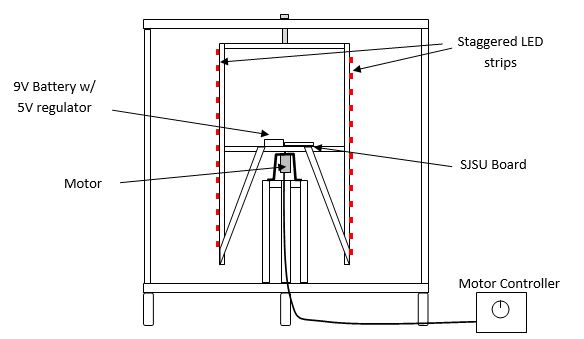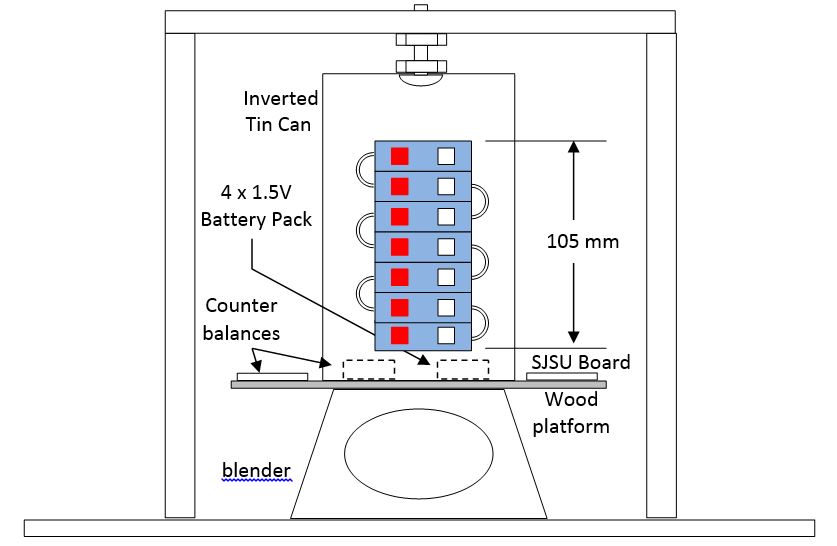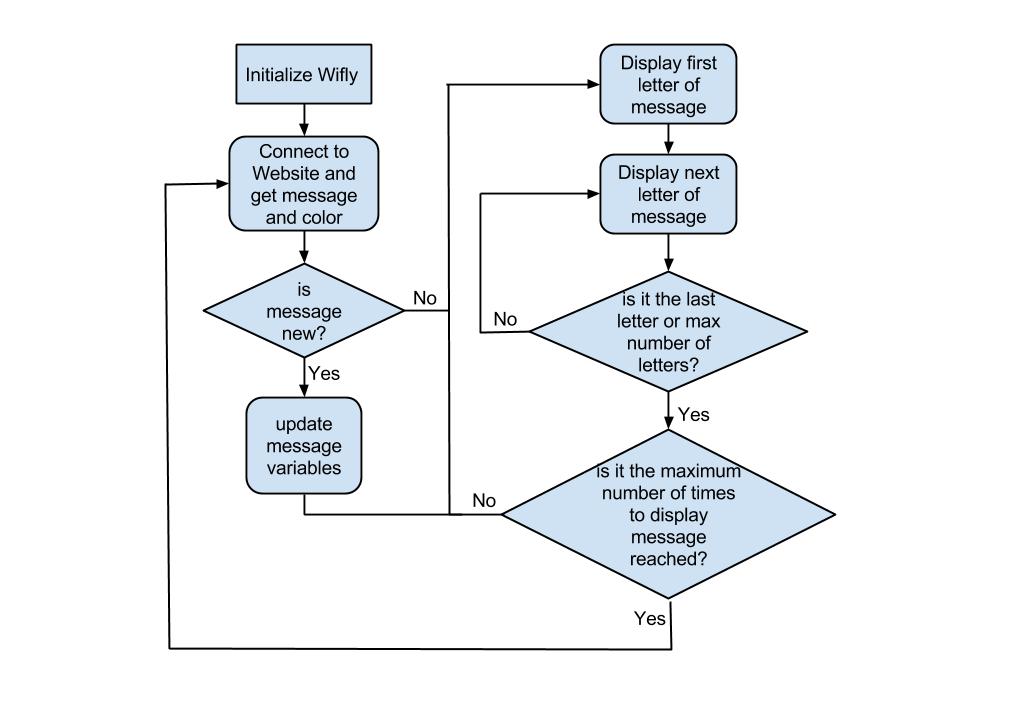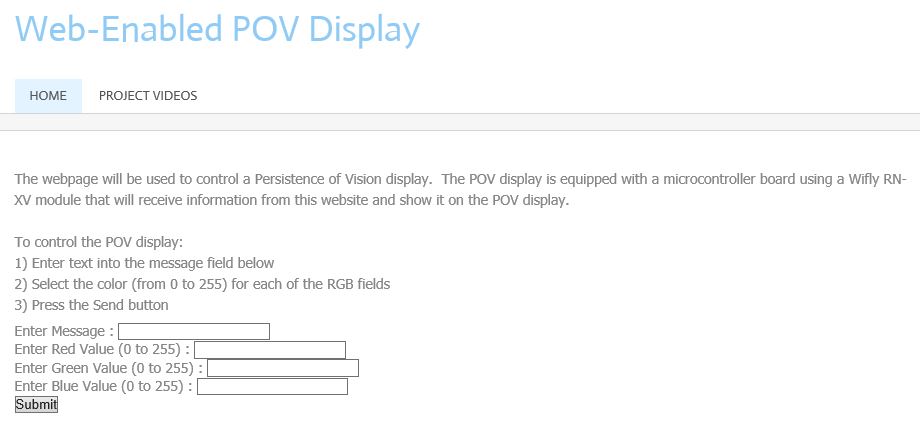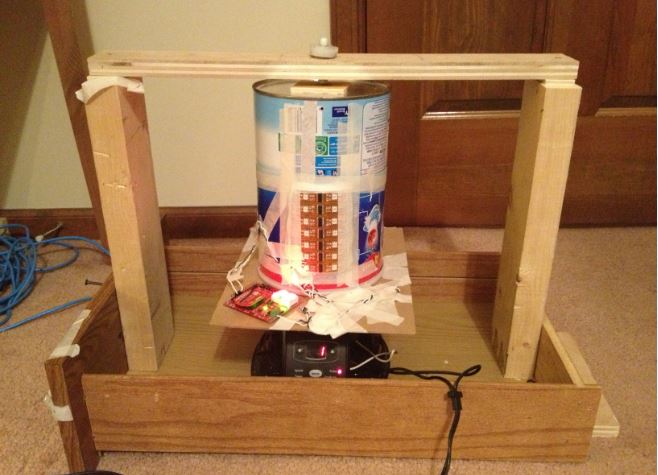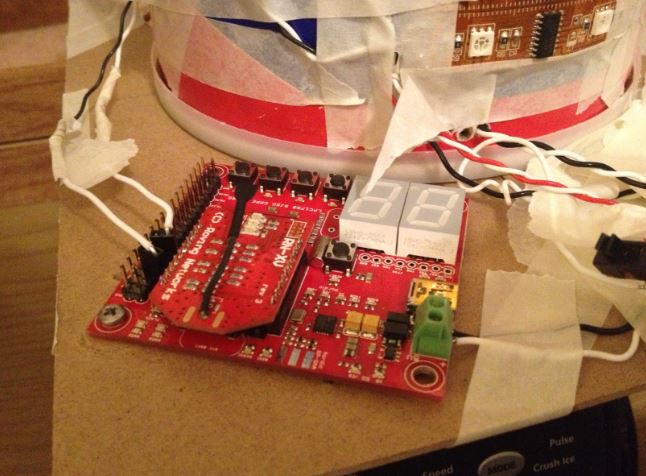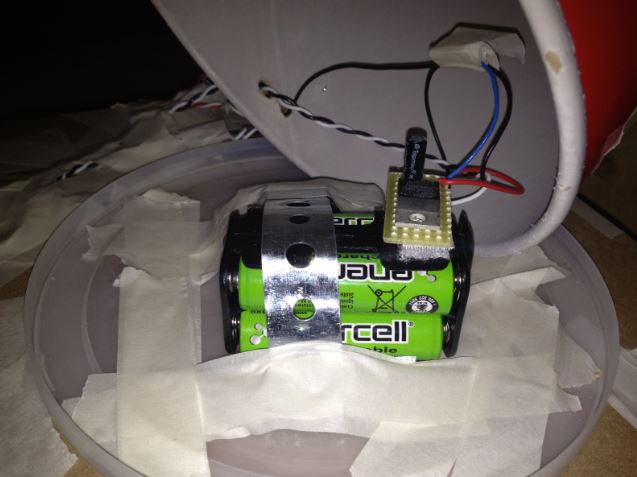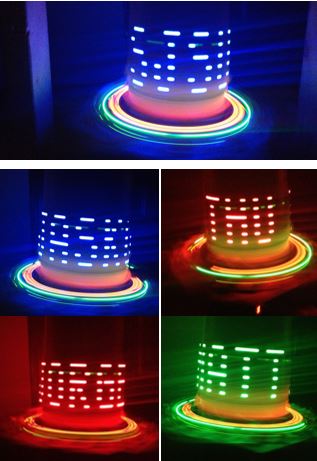F13: POV Display
Contents
Web-Enabled Persistence of Vision Display
Abstract
The purpose of the project is to build a Persistence of Vision (POV) device that is controlled by the SJSU One board. The POV device will display a message that is input by a remote user via a website setup for this project. The message will be received by the microcontroller using a Wifly RN-XV module integrated onto the SJSU board. The microcontroller will interpret the message and drive the LEDs via an SPI interface to display the message on the POV device.
Figure 1 shows the overall system diagram:
Objectives & Introduction
The objective of this project is to learn how to use the SJSU One board and to control external devices using the interfaces provided on the board. Two types of interfaces will be used. The microcontroller will communicate with the Wifly RN-XV module via a UART interface. Then the LEDs will be controlled using an SPI interface. The LEDs will be mounted onto the mechanical POV device and the microcontroller will drive the LEDs to produce the message. A website will be setup to provide a user interface to control the device.
The team will be divided into two groups. Team 1 will be responsible for the web interface and integration of the Wifly module on the SJSU board to communicate with the website. Team 2 will build the POV device and write the driver to display the user message on the POV display. A summary of the team and responsibilities is shown below:
Team Members & Responsibilities
Team 1 (Jorge Del Valle and Matt Heffner)
- Website Development
- Wifly module setup
- Front end communication from website to microcontroller via the Wifly RN-XV module
Team 2 (Jasko Begovic and Thu Hoang)
- Construction of the Mechanical POV device
- LED driver software
Both teams will participate in the integration and testing of the project.
The project will take 6 weeks to complete. The following table shows weekly project milestones and the team's progress.
| Date Planned | Milestone | Status |
| 22-Oct | Wifly part received; POV parts ordered and shipped | Complete |
| 29-Oct | Integrate Wifly to SJSU board and connect to Wifi connection | Complete |
| 5-Nov | Finish mechanical assembly & any electrical interfaces (Hall effect switch.) Read datasheets, obtain necessary libraries for LED device, understand & modify libraries to work with SJSU board Setup Website for user interface to the device | Complete |
| 12-Nov | Implement code to receive data from website via the Wifly module | Complete |
| 19-Nov | Finish code for LED driver. Display the alphabet. Start integration of the Wifly portion with the POV device | Complete |
| 26-Nov | Project testing. Have working Assembled code with Web-half & test by inputing various strings via the website | Complete |
| 3-Dec | Present demonstration and submission of project report | Complete |
| 7-Dec | Present demonstration and submission of project report | Complete |
Parts List & Cost
| Part | Cost |
| Wifly RX-NV module | $35 |
| Web Hosting through iPage | $12 |
Design & Implementation
The user interface for the project will be http://povdisplay.com. The user will input a message to be displayed on the POV device, as well as, the RGB color to use. This section will detail the hardware and software components of the POV device.
Hardware Design
The hardware design section will discuss the details of the POV device. The SJSU board will be installed onto the device. The following section outlines the mechanical design
Mechanical Requirements
The POV display requirements were necessarily derived from the physical dimensions of the LED strip and the dot matrix font that was chosen. The strips chosen are Adafruit LPD8806 RGB strips, primarily because of their high refresh rate at 4000 Hz[4]. The font chosen is reproduced below in Figure 1 for discussion.
Figure 2: Dot Matrix Font for the POV display
In order to display a single character, the display’s width should be a minimum of 5 pixels wide. Using the LED strip’s dimensions as a starting point, the RGB pixels are 5050, meaning half a centimeter wide by half a centimeter tall, and are spaced 31 mm apart. If the strip’s pixel spacing is maintained, then the display should be 6” wide as a minimum so that the viewer can see 5 pixels across. If instead two strips of LEDs are used, with the strips staggered vertically so that the LED spacing is halved, then only a 3” minimum diameter is needed.
Figure 3: Diagram of staggered LED strips
Initially, a personal blower was thought to be sufficient to provide the framework on which to build the POV display. The rotating cylinder of blower has dimensions of 3” diameter x 5” tall. This is sufficiently wide to display a single character; however, with the manageable sized cylinder came the small sized motor. Since this motor was not intended to move anything but air, it does not have enough torque to move the combined weight of the board, LED strips, wires, and battery pack. A motor with a higher torque is needed.
In addition to the higher torque, the motor needs to have sufficient speed. POV displays work on the principle that an afterimage persists on the retina of the human eye for approximately 40 ms[2] (1/25th of a second). Therefore the motor must be able to spin a pixel a complete revolution in 40 ms or 25 Hz. 25 cycles per second translates to 1500 rpm minimum.
Suppose now that the display is 12.6” or 32 cm in diameter. If no horizontal spacing between the pixels are allowed, then that translates to pi*32 /0.5 = 201 pixels around the circumference. The entire circumference must be refreshed in 40 ms to maintain persistence of vision. When using a single strip, the LED must transition from one column to the next in 40ms/201 ~ 0.2 ms. Therefore the minimum refresh rate needed for a display of this size is 1 / 0.2 ms = 5 kHz, slightly higher than the refresh rate possible with the LPD8806. Therefore, some horizontal spacing between the pixels is required for a display of this size. If a spacing of 1 pixel is used, then the refresh rate can be halved to 2.5 kHz.
A display rotating at 1500 rpm that requires a high torque, high speed motor must be precisely machined to operate safely. Since this is not possible within the self-imposed budget constraints of the project, we chose the best possible speed that can operate safely with manually crated components. This motor is the 12V, 500 rpm motor from BatterySpace.com. For “Saturday morning cartoon” quality POV, 500 rpm is sufficient since the same picture is used 2 to 4 times when running at 25 Hz[2], thus reducing the speed requirements by half to a quarter, and the 1500 rpm can be reduced to 750 down to 375 rpm.
The LED strips naturally lend themselves to the SPI bus since it is wired for serial communications with a Data In and Clk In and a Data Out and Clk Out. To refresh the 32 LEDs at 4 kHz with each LED requiring 24 bits of information would require the SPI bus to operate at 32 x 24 x 4 k = 3.072 MHz at the very least. Fortunately, testing shows that the SPI bus can be operated at this speed and up to 6 MHz without issues. From the datasheet, each 5050 LED requires approximately 5V and 60 mA[5] to operate, thus the POV display of 32 LEDs would require approximately 2A peak. This kind of current requires either a four-pack of AA battery or a 9V battery regulated down to 5V.
The requirements are summarized below:
| Requirement | Detail |



